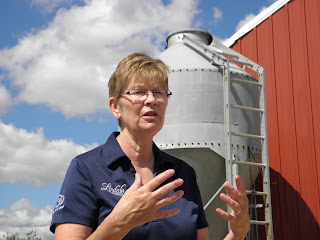 |
With celebratory rides on combines the 'City Mom'
2015 tour season comes to an end. |
The Illinois Farm Families 'City Moms' went on the last of this season's farm tours in October. Despite my increased awareness of the extensive winter work that continues behind the scenes, every year, on every farm; from my perspective as a city mom, we ended the season appropriately, with a harvest tour.
Invited to complete our season with the opportunity to ride in the combine and the grain wagon, this was an exciting and somewhat celebratory tour. I am sad to see the season come to an end. We have met so many amazing Illinois farm families. I've had such a good time and learned so much on each tour, much more than I've yet been able to integrate completely into my food purchasing, preparing and serving of meals to my family.
The Larson Farm
Our last tour was of the the Larson Farm in Maple Park, IL. The Larson family farm produces beef and grain. Three generations participate in farming on the Larson farm. Mike and Lynn Martz partnered with Lynn's parents in 1979. Their son Justin and his wife joined them in 2008. Several employees contribute to farm operations and are an integral part of the farm. With several generations represented in the family and inter-generational employees on the farm there is a strong sense of extended family and community overall at the Larson farm.
 |
| Larson Farms |
The crop production side of their farm is managed by Lynn and includes corn, soybeans and wheat grown on 6,350 acres of land. They also raise and finish beef cattle, Mike's domain. They have the capacity to house up to 3,500 head of cattle and finish 7,000 head each year. These cattle are delivered via semi-truck to the Larson feed lot where upon arrival, they are allowed ample time to rest and recover from the stress of travel. The feed lot houses and cares for the animals of other farmers and finishes them for the market.
Animal Well Being
Every animal is observed on a daily basis at the Larson farm. Technology contributes to the assessment of each animal's well being and development. Ultra-sound technology is used in determining fat content, marbling and readiness for the market. Facilities for the cattle on the Larson farm were designed by the well known consultant to the livestock industry, Temple Grandin.

Antibiotics are only used on sick animals and following any antibiotic treatment, there is a required withdrawal period before that animal can be taken to market. There is oversight and inspection by government regulators and ample testing required to insure that there are no residual antibiotics in the meat. Mike Martz also presented information regarding the use of hormones in beef production. Hormones naturally occur in cattle (and other organisms). Any additional hormones are given to assist an animal in utilizing their feed to promote growth. A farmer may choose to use additional hormones to improve efficiency and reduce the environmental impact of raising cattle. Useful comparison information regarding hormones to consider includes the fact that a 3 oz. cut of treated beef contains 1.9 nanograms of estrogen compared to 1.3 nanograms in a 3 oz. cut of untreated beef (that's a .6 nanogram difference), a potato contains 225 nanograms, a 3 oz. serving of peas contains 340 nanograms, a 3 oz. serving of cabbage contains 2,000 nanograms and one birth control pill contains 35,000 nanograms of estrogen. (Source below.)
For the source and more information regarding the specific amounts of naturally occurring hormones, please read the article from the University of Nebraska:
http://newsroom.unl.edu/announce/beef/2846/15997
Back to the Farm
There is an amazing amount of work to be done and managed on the Larson farm. Our visit coincided with the fall corn harvest. We rode on the combine on the 27th day of consecutive 15 hour work days for those driving the equipment. Despite the timing, we were met with enthusiastic and talkative field guides as we watched the harvesting of the corn from the combine cab.
To get your own glimpse into work and life on the Larson farm, view the video;
https://www.youtube.com/watch?v=_f3dmiorenU
http://www.larsonfarms.com/#!city-moms-2015/p5br6
So Much to Learn
We have been presented with so much information and have had the opportunity to have an inside look at farming on each and every farm tour that it is hard to readily absorb and process it all. Visiting the Larson family farm was no exception and we were once again treated with warm hospitality and straight forward honest answers to every question.
For me the big picture takeaways from the Illinois Farm Family 'City Moms' tours were:
- Illinois Farmers are dedicated hardworking people with the best interests of their land, their animals and their consumers at heart.
- They offer high quality products to consumers.
- They care.
- They are regulated.
- They respond to the market.
- They want consumers to be healthy, informed and to have choices in their food purchases.
The Illinois farmers we met this season are committed to informing consumers about farm production. They have been more than generous in sharing their time, knowledge and their farms with us.
Whether it is through a program like the one offered by Illinois Farm Families, by visiting your local farmers market or just asking questions of the managers of the grocery store where you shop, I urge you to find and get to know the farmers who produce your food. You will increase your knowledge about the food you eat, gain confidence in your purchasing choices and meet amazing people.

























































